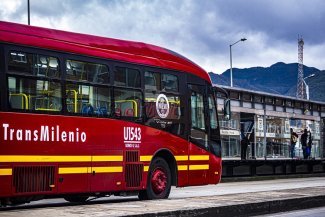Trade unionists in Colombia have begun the year with the sobering news that violence against workers and worker activists is on the up.
According to preliminary figures gathered by the Colombian think-tank Escuela Nacional Sindical (ENS), 26 trade unionists were murdered between 1 January and 11 December, 2013.
ENS also recorded 13 attempted murders, 149 death threats, 28 cases of intimidation and 13 arbitrary arrests.
This represents a 15 per cent increase on 2012 when 22 trade unionists were murdered and six were the victims of attempted murders.
The two most recent assassinations took place in early December in the department of Norte de Santander in the city of San José de Cúcuta and the municipality of Sardinata.
The victims, Pedro Camperos and Carlos García Herreros, were branch trade union leaders of the public servants federation FENASER (Federación Nacional de Servidores Públicos), affiliated to the Confederación de Trabajadores de Colombia (CTC).
University lecturer García Herreros was recently elected leader of FENASER in Norte de Santander before he was shot in the chest and killed on 4 December 2013.
Although authorities claim he was the victim of a robbery, Raúl Gómez, president of the Norte de Santander branch of FENASER, points to rumours of a paramilitary trade union hitlist as the more likely motive.
The second case took place two days later, on 6 December, in Sardinata.
According to Gómez, Camperos who was branch president of SINDENORTE, a local public services union affiliated to FENASER, was well-known locally, where he worked as a musician as well as being a member of the municipal council.
Camperos was killed when he was invited to play on the outskirts of the city, where assailants attacked the vehicle in which his band was travelling. Another band member was also killed in the attack and the driver was injured.
Leaders targeted
These alarming figures demonstrate that, despite government assurances to support the free exercise of trade unionism, violence against trade unionists and the impunity enjoyed by its perpetrators is still a major issue in Colombia.
The fact that Colombia has applied for membership of the Organization for Economic Cooperation and Development (OECD) makes the situation particularly concerning.
The ENS data also further reveals that 90 per cent of the attacks in Colombia targeted trade union leaders. Of the 229 cases of violence against trade unionists registered, 208 involved union leaders.
In addition, 18 of the threats registered were collective, and directed at organisations affiliated to the CUT and Confederación General del Trabajo (CGT).
These trade union confederations were the targets of 89.2 per cent and 5.4 per cent of the attacks, respectively, which confirms the collective dimension of anti-union violence and its repercussions.
Analysis of the economic sectors most affected by anti-union violence in 2013 reveals that the mining and quarry sector was worst hit, racking up 25.4 per cent of the cases, followed by manufacturing (19.3 per cent), education (18.2 per cent) and agriculture, hunting and fishing (12.7 per cent).
With regards to the perpetrators of the violence, there is no information available in the majority of cases (53.7 per cent). But, in the cases where there is a known or alleged perpetrator, 71.6 per cent have been attributed to paramilitary groups, 19.1 per cent to state bodies and 5.8 per cent to guerrilla fighters.
Other serious cases
There are a number of other cases which also demonstrate the obstacles trade unionists face in the free exercise of their activities.
For example, Igor Díaz López and Aldo Raúl Amaya Daza, the president and treasurer respecitvely of the National Executive of the coal industry union Sintracarbón (Sindicato Nacional de Trabajadores de la Industria del Carbón), have received repeated threats against their families. The threats were issued whilst the two leaders representing the union in the collective bargaining process with Colombia’s open-pit mining company Carbones del Cerrejón Ltd.
The sugar industry is another hostile arena for trade unionists, especially at La Cabaña Sugar Mill in Colombia’s La Cauca region, which continues to hire workers through subcontractors.
It also refused to recognise the branch union, Sintrainagro (Sindicato Nacional de Trabajadores de la Industria Agropecuaria), or to discuss the collective bargaining proposal submitted by the union in December 2012.
On 3 January 2013, the sugar mill dismissed 86 unionised workers, including the union’s executive members, and numerous workers received threats against themselves and their families.
Later that month, on 28 January, Juan Carlos Pérez Muñoz, a trade union activist, was murdered in the municipality of Corinto, in Cauca.
The assaults on female trade unionists are another worrying dimension of anti-union violence.
Female workers and union leaders are the victims of threats and forced displacements, designed to undermine their leadership and their lives as women.
An illustration is the experience suffered by Martha Cecilia Suarez, the president of the Santander public servants association. ASTDEMP (Asociación Santandereana de Servidores Públicos).
Suarez has been under constant attack since 2004, but in April 2013, a message was left at her office, declaring her a military target and a public enemy.
She was also sent two dolls covered in red paint. Each doll featured the names of her daughters – one without an arm and the other without a leg. The threat was signed by the paramilitary group Comando Urbano de los Rastrojos.
Equal Times and the ITUC recently launched a campaign to call for an end to violence against trade unionists in Colombia.
To sign the petition and to tell President Juan Manuel Santos to end violence against trade unionists immediately, sign here:
http://act.equaltimes.org/en/colombia2013
An earlier, unedited version of this article was originally published on Agencia de Información Laboral-ENS.









